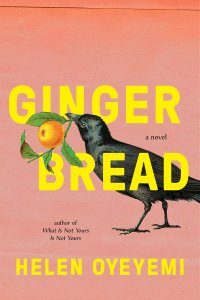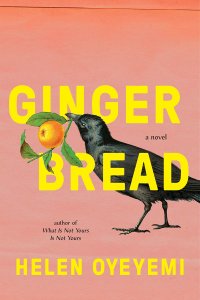Katharine Coldiron Reviews Gingerbread by Helen Oyeyemi
 Gingerbread, Helen Oyeyemi (Riverhead 978-1-59463-465-9, $27.00, 272pp, hc) March 2019.
Gingerbread, Helen Oyeyemi (Riverhead 978-1-59463-465-9, $27.00, 272pp, hc) March 2019.
Make no mistake: Helen Oyeyemi’s sixth novel is literary fiction, with a profound central metaphor and wandering, unfixed storylines. Its language is heady and attention-getting: “Flowers wilt and shed mottled petals, mold blooms greenish-white on chocolate truffles, and Harriet’s gingerbread hunkers down in its tin, no more attractive than the day it arrived, but no more repellent either.” But it’s also a whimsical, unlikely novel of fictional countries, talking dolls, and ghostly realms. The genius of Oyeyemi’s writing lies in the collision of fantastical whimsy with acidic malice; this is not a fairy tale where the reader feels safe entering the forest, because it’s not at all certain that the cute children will ever come out again. That tension, and Oyeyemi’s extraordinary imagination, lift Gingerbread well above the average literary fantasy and make it something lasting, something rich and lovely and tangy and dark – like the dessert of its title.
Three generations of women hold the central parts in Gingerbread: teenaged Perdita, her mother Harriet, and Harriet’s mother Margot. They live in a recognizable world in the present day, but Harriet and Margot are from Druhástrana, “an alleged nation state of indeterminable geographic location… Several prominent thinkers have proposed reclassifying Druhástrana as a purely notional/mythical land.” The meat of the novel takes place in this notional/mythical land, telling the story of how and why Margot and Harriet emigrated from there, and how Perdita came to exist. A sturdy frame at the head and tail of the book first sets up the stakes for Perdita’s need to understand her origins, and then lays out the steps a person must take in order to start her life again after setting the past aside.
Underneath Oyeyemi’s fresh style and extensive characterization lies a pretty mundane family story: a rich daughter (Margot) runs off with a poor man and becomes desperate to improve her situation, while the family schemes and withholds help to torment her. Margot’s desperation leads her first to send Harriet into a weird, benign kind of slavery, where she must work as a “Gingerbread Girl” in a creepy, Disneyish tourist trap. Next, they immigrate to England, where some cousins allow them to join their household but hold them at arm’s length. The book’s powerful characterization never lets up, as Harriet observes, for example, her new benefactor: “Everything about him was lean and tense and rectangular; he was tuned into conversational subtext at a frequency that caused him nervous headaches.”
Complicating all this is Gretel, a self-defined changeling who forms a bond with Harriet as a child. Gretel appears and disappears from the narrative without much logic, and her meaning in the context of the book never fully clears. She is something of a Puck figure, but also a bosom friend who genuinely cares for Harriet. She might be a lost love or a figment of Harriet’s imagination. Even when the book turns toward her in its final few chapters, she fails to come into focus. Gingerbread has a certain inward quality, in its quirky structure and the speed at which its speculations become definite, and Gretel is an enigma to which perhaps only Oyeyemi has the whole answer.
Additionally, the book’s influences are a glorious jumble. Oyeyemi has written a novel that calls to fairy tales both ancient and contemporary, and its characters have an odd fixation on 19th century French literature (Zola, Balzac) – yet there’s a whole subplot about the ridiculous parents’ association at Perdita’s school, a mini-Where’d You Go, Bernadette in the middle of this entirely different novel, and the situation with Margot’s family recalls Jane Austen’s Mansfield Park. The language of the novel ranges similarly, from slightly baroque to nearly minimalist. However, it never fails to compel: “Harriet ate a piece of gingerbread and tingled all over. It was a square meal and a good night’s sleep and a long, blood-spattered howl at the moon rolled into one.” Gingerbread is subject to multiple descriptions in the book that bears its name, but this could pass for a description of that book, as well.
Even for a fairy tale, Gingerbread tells a highly improbable story, and it’s packaged in a lopsided and unpredictable narrative. That’s what makes it such a terrific read. It’s a book flawlessly tuned to the most obscure radio station on the dial, and, even though it’s unlike most other fiction – fantasy, literary, or crossover – its delights are bottomless.
Katharine Coldiron is the author of Ceremonials (Kernpunkt Press), an SPD fiction bestseller. Her work as a book critic has appeared in The Washington Post, The Believer, The Guardian, and many other places. She lives in California and at kcoldiron.com.
This review and more like it in the January 2020 issue of Locus.
 While you are here, please take a moment to support Locus with a one-time or recurring donation. We rely on reader donations to keep the magazine and site going, and would like to keep the site paywall free, but WE NEED YOUR FINANCIAL SUPPORT to continue quality coverage of the science fiction and fantasy field.
While you are here, please take a moment to support Locus with a one-time or recurring donation. We rely on reader donations to keep the magazine and site going, and would like to keep the site paywall free, but WE NEED YOUR FINANCIAL SUPPORT to continue quality coverage of the science fiction and fantasy field.








